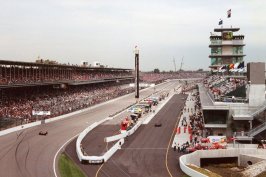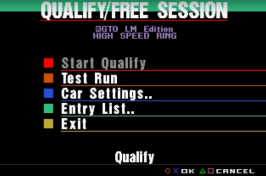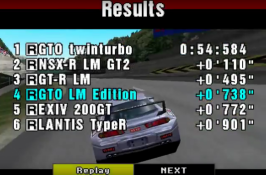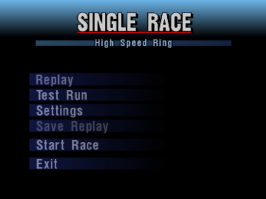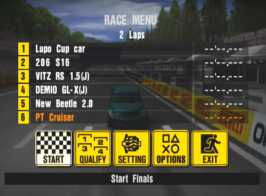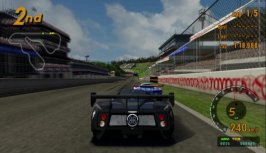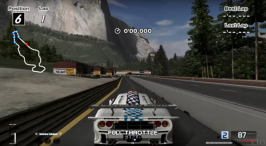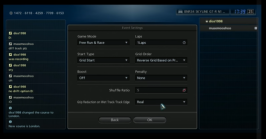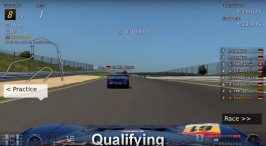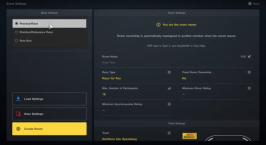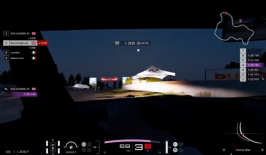Matej
Premium
- 2,002

- Zagreb
The History of Qualifying and Test Running in GT

*Banner image by GrumpEone and BH-21

*Banner image by GrumpEone and BH-21
All images that are about to follow were taken from the internet, captured from a video or a website.
INTRODUCTION
All right, today we talk about two main ingredients every driving simulator should have - qualifying and test run.
The idea behind qualifying is to climb up the grid and minimize traffic ahead of you upon entering the first set of corners. In real racing qualifying can have a huge impact on outcome of the race. What kind of role qualifying will play in driving games will depend on how the game is structured and how difficult it is. It's important to remember that while there are many ways to simulate a good qualifying session, even the most ingenious solutions will be worthless unless the game adopting it can't boast about good artificial intelligence.
And when I say good, I mean fast, because speed is exactly what your opponents need in order for the player to justify spending his time on qualifying. There is no real need to qualify if you can wipe the floor with your opposition after two, three corners already, don't you agree?
Test run is pretty much self-explanatory. It helps you find ideal settings for your car and familiarize yourself with the track you're going to compete on. That's why test running is often more essential than qualifying. I can't imagine playing a driving simulator that doesn't have some kind of open pre-race mode for testing your car or a track. Unfortunately, games like this exist. I'm especially in love with those that have one-try qualifying sessions, but not a test run.
Both qualifying and test running can be refined to the point of being over-designed. Best solutions provide the player with a telemetry, AI cars randomly coming out from a pit box, and so on. Still, you do not need magic and big budget to properly simulate these sessions. Even sticking to the basics can do a miracle, you just need to employ them properly.
So... how did the father of the genre got this? We'll find that out as we cover one GT game at a time, investigating how Polyphony has been approaching this matter during last 20 years.
GT1
The original GT game featured both qualifying and test run, no less. For a PS1 game featuring over 100 cars and detailed graphics, this was just a cherry on top of a sweat crème cake.
The system had some downsides, of course. The pre-race menu was made of two separate screens, the first one being reserved for tweaking your car before qualifying session, and the next one for tweaking your car for the actual race. This meant that if you wanted to jump straight into the action without making any changes to your car, you had to skip the qualifying screen first, wait for the game to load, and then skip the last screen to commence with the race.
Assuming you're not doing test running, the game had to load twice before letting you race. Or bail out. Yes, you also had to skip the qualifying screen first if you wanted to abandon the event. The system obviously wasn't the most user-friendly solution in the world, but I am quite positive back in 1997 nobody cared about that.
Anyway, qualifying in GT1 is easy to understand. All you need to do is complete a single lap around given track as fast as possible. Once you cross the chequered flag, the game lists down lap times of your AI colleagues, and ranks you accordingly. To my knowledge, AI qualifying times are constants that never change as long as you compete against the exact same lineup of computer cars. For instance, no matter how fast or slow I was during a qualifying session for the first race of the Normal Cup at Winter Ring Maxi, qualifying time for the TRD 3000 GT on that track would always be exactly the same.
I don't mind competing against fixed ranking board (unless you're paying close attention, you wouldn't notice times are constants), but it does bother me that times shown for AI cars during qualifying have nothing to do with how they perform in actual race. How is possible that I miss a pole position by staggering 11 seconds with a stock Demio GL-X during a qualifying session for the second race of the Sunday Cup at Slow Speed Ring, yet I finished the actual race 3rd?!
On another occasion I wasn't even trying to set a fast qualifying lap, yet I qualified approximately 3 seconds ahead of everyone else. But then the race started and I literally got creamed, I couldn't do jack to stop them from overtaking me one by one. Needles to say, I lost after two laps already. This wasn't in the Sunday Cup, rather in the Tuned Cup, at the nighty night Clubman Route XVI. Different car in a different scenario, but with the same outcome.
That's the problem I have with the qualifying system in GT1, you can't use it to figure out strengths and weaknesses of your opponents. It is far better to rely on Entry List that shows you who exactly you're competing with and what kind of power and weight figures he's keeping up his sleeves. But once again, that was in 1997, nobody cared if qualifying had issues or not. We had it, and that was all that mattered.
Test running in GT1 is evidently simple, but works just as it should. You can run infinite number of laps and practice as much as you want without AI cars interfering. In endurance events tire wear icon appears in test run mode as well, allowing you to freely monitor wear rate of your tires and try out different sets and driving techniques. This is extremely helpful, who would want to gamble with tires on a race lasting over 60 minutes?
GT2
For the next game in the series - famed Gran Turismo 2 - Polyphony decided to completely rule out qualification system. This came as no surprise considering the game introduced so much additional content that it had to be launched on two discs. Insisting on a huge list of fixed qualifying times for each AI car on each event would scatter the game across three discs at least. The game was already as chock-full as it could get.
Besides, I don't think GT2 would have benefited from a qualifying system that much anyway. Rubber banding (keeping the AI cars close to you) was often so evident it didn't really matter from which starting position you set off. A single mistake on either side could rapidly change the arrangement of cars running to victory. On some occasions (e.g. beginner races) only luck would determine whether you win or lose, assuming of course, you weren't trashing the race with an overpowered car.
Perhaps they insisted on rubber banding to cover for the lack of qualification. Or maybe they just wanted to make the racing feel tense and unpredictable. Well, not a bad idea, but it makes the racing feel unnatural at times.
Simply put, qualifying in GT2 would have been a good addition, but serving under the existing system wouldn't make much impact on the overall gameplay.
Test run mode remained in the same format that was in GT1. This time, however, they added an option to watch a replay of your pathetic run and even save it if needed. In addition, the HUD would always keep five of your last laps visible, no longer two. Checkpoints were added, telling you how fast or slow you were at given spot on track. All that was a great improvement over its predecessor, mostly going in favour of people who wanted to keep an eye on their consistency.
All in all, they did a good job with GT2. Although we didn't get a qualifying mode, test run became better than ever.
GT3
Next stop, Gran Turismo 3. This was the first GT title to arrive on PS2, which meant it could utilize some of the console's new abilities to improve qualifying and test running.
To my surprise and happiness, the qualifying system returned, introducing a major revision to the concept. Instead of running a single lap around a track, you were now given an infinite number of laps to set the fastest qualifying time possible. Before attempting to do so, however, you had to complete a warm-up lap around the track to... warm up the tires for the race, much like real racers do it.
Another novelty was the introduction of traffic. No longer you had to play role of a lone wolf, five other computer cars would now run together with you, trying to set their own qualifying times just as you do. This meant that the times set by your colleagues weren't constants anymore, but valuable data you could use to measure how you would stack up in the race.
Furthermore, the game would now keep the track of the currently fastest qualifier. Whether that be you or one of your automatons, you always had a target to aim for as you drive around the course. After each passing checkpoint, you get to see whether you're keeping up with that time or not. Assuming you wasn't the one who set the fastest time, it was possible to learn on which sectors your fellow AI buddies perform better and on which they slack off. All these details meant a lot for the overall atmosphere of racing and realism.
Of course, after a period of gazing and praising came the period of criticizing. These issues aren't important, but we have to point them out.
A forced warm-up lap meant you had to stay on track a minimum of two laps two set a qualifying lap. If player was in rush, and the race was taking part on the longest track in the game with a car slow as hell, tension and jabbering would soon flood the entire room, hurting anyone who's in player's vicinity.
Also, since you always start ahead of your rivals on each qualifying session, it is possible to lap the course before your AI simpletons do it for their second time, thus avoiding updating the board with their laps set on warmed-up tires. That way you could make your qualifying a bit easier.
You also can't watch replay of your qualifying run. Nothing to complain about, but was there a reason not to include that?
Test running no longer existed as a separate game mode, but was blended with qualifying instead. I mean, there was no reason why you couldn't use the qualifying mode for testing your car since the game doesn't overwrite qualifying times next time you come in and you could do just about everything you could had the mode been separated.
One trick I always liked in races with tire wear option on, you could witness AI car making a pit stop for a set of fresh tires should you decided to stay on the track long enough. By doing this, it was possible to find out what tires your rivals were using and plan your pit stop strategy accordingly. GT3 was the first game in the series to emphasize the significance of tire wear and pit stop strategy, so this was like a gift from heavens to players with enough time on disposal.
There was also another little detail - the fact you had to use a qualifying mode to do some test running automatically meant that a player who wished to start from the back of the grid would need to quit test running before reaching the finish line, otherwise his position on the grid may see a change. This was definitely a problem for those who wanted to run few laps without interruption, but with such approach it couldn't be avoided.
Anyhow, GT3 brought a very interesting two-in-one session concept. It does have drawbacks, but most players won't notice them. As a matter of fact, most players think that this is the best approach to qualifying and test running the series has ever had.
GT4
After impressive comeback to qualifying and three years of intense developing for next big GT game, nobody could guess that the last GT title scheduled for release on this great platform would get perhaps the worst qualifying and test running system the series has seen by then. And why is that?
Because there is no one, that is why! Well, at least not when running each race individually. You see, much like in GT3 sometimes you choose to run each race in the event individually or in succession, like a championship. The major difference is that in GT3 you could qualify regardless of how you undertake an event, but in GT4 qualifying appears only if you participate in a championship. Why is this such a problem?
Imagine you have decided to take on the Super Speedway endurance event. Imagine you have stumbled across a first-rate selection of opponents that guarantees gruelling and exciting race. You wouldn't want to lose that, right? Of course, to ensure nothing would go wrong, you would need to click on that strawberry-painted toolbox and spend some time in it, carefully altering all the settings that may be important for the race. You know, gearbox, tires and all that stuff.
But before you can decide on settings, you need to test them, right? And how are you going to test them if you don't have a mode to do it? There you go, this is the reason for my complaint above. You have no other choice but to tweak the car according to everything you know and pray it will work in the race. Is this what you really want to do? Is this what professional drivers do as well, gamble?!
In addition, some of the races in the game take place on tracks that are either extremely narrow or simply difficult to master. On such tracks practising is mandatory, and often so is qualifying, since you know you'll be dealing with computer cars that are rarely aware of your presence. Collisions and frustration are unavoidable on each pass, but without qualifying you don't have much choice.
My only question is - why? How is possible that after three successful games they can't get the basics right?
Now, about these championships... we already said that if you enter a series of races you get to compete for points and bonus prize money. In these events you do get to practice or qualify as much as you want, in a single mode at that, just like in GT3.
But why does the icon say "Practice" only? How about "Practice & Qualify", because that is exactly what you can do. Seriously, when I first discovered this mode I didn't even realize you could qualify until I noticed by accident that my grid position changed after crossing the finish line for the second time. In GT3 it was easy to figure it out because it said "Qualify", not "Practice". They should have named the icon differently, in its current state nothing implies you can move up to grid if you run more than one lap.
Anyway, the system works just like in GT3, one warm-up lap to trigger the lap counter and infinite number of laps for as much practice as you desire. This time, however, we have a simplified HUD that doesn't provide enough information. Not only you get to see only one of your last laps instead of three (like in GT3), but you don't have an image of a car showing who is in the front and what lap he has set, you can only make a guess by looking at split times.

GT4 had lots of tracks, on many of which you had to practice a lot have you just been introduced to the game.
In addition, if you head into the pit for a set of fresh tires, the game will stop and you will be brought back to the pre-race menu. Oddly enough, the AI cars can pit in and change their tires, so why can't you? WHY?
To make things worse, once you exit the session, the pre-race menu doesn't state qualifying times for each car, only the final order of the cars, so you can't even tell how fast other cars in relation to each other are. Peachy.
I never liked GT4 that much anyway, so this step down isn't really a news for me, but it sure will be for any serious player coming from any previous GT game. Hell, forget about serious players, even casual peeps will despise going into time trial mode just to learn a course.
GT5
Now... how about we move on to GT5?
The third generation of Sony's renowned console, coming with a long-desired network system. To tell you the truth, I expected a lot from GT5. Not only because it was in development for so long, but also because it was about to utilize the console's new feature that would inhale completely new dimension of gaming to the series' well-established concept. This was no longer a traditional GT game we used to play in the old days of PS1 and PS2, but a turning point for the genre and the series. Naturally, I was eager to find out how it would turn out. Will it be the best GT game to date? Will qualifying and test running return in style?
Well, the result in that regard was a mixed bag. You see, while the online portion of the game got wealthier for the pre-race sessions we so dearly wanted, the offline part of the game was completely neglected. Remember when I said in GT4 you could only practice and qualify if you did a series of races? Well, in GT5 you can't do it anyhow, regardless of how you enter the race. What a let down. If by 2010 they couldn't figure out it is utterly inconvenient to test your car in time trial just because the race itself doesn't have a test run mode, there is something wrong with the series. Once again, testing your car before the main event is crucial, especially when you throw in dynamic weather and day-night transition.
Besides, GT5 had the slowest loading times ever seen by then, so try to guess how much of a bother is to go back and enter somewhere else. You have no idea.
Luckily, the online portion of the game was spared this crap, so the players could practice for as long as they desire. As far as I could investigate, stand-alone qualifying mode doesn't exist, instead there is a "Free Run" mode before or after which the host of the race can arrange the players' cars by their pace, whether slower or faster. The idea of blending two modes into one is identical to one used in GT3 and GT4, but in GT5 it was further refined for the sake of delivering proper competition between actual humans.
The only thing I couldn't figure is whether the host has to set how long the Free Run will last before the race countdown starts ticking, or he has to do it all manually. Whatever the answer is, it seems the system worked fairly well, and I haven't really heard of any bugs that would ruin the experience (apart from typical disconnection and lag issues). For private clubs and communities that were pursuing legitimate and realistic racing this was as good as they could get.
It also seems you can see maximum of 3 laps at a time, assuming you hide that big-ass table on the right listing all drivers competing in the race. Sometimes you may want to leave it be, as you can then closely monitor changes on the grid according to who is faster at given moment. Pretty good.
GT6
Rather than being a new game, GT6 felt more like an upgrade to GT5. The physics improved, majority of the bugs were fixed, and later in its life we even got a track editor in a form of an application. Unfortunately, the game had one big problem - the artificial intelligence. As opposed to GT5, the career mode in GT6 consisted of races that could be best described as driving missions from GT4. Seriously, there was hardly any opposition there, unless you counted nuisances standing in your way as one. So I can understand why there was no qualifying in GT6, but there is no excuse to why we couldn't we get test run mode at least. GT6 came in 2013, and it was the 6th entry for the developer, built on a multi-million budget. That's all I will say.
Luckily, as far as online was considered they got things right with qualifying and test running. Unlike in GT5, qualifying was now separated from test run and had its own set of rules. Most importantly, they added a number of little details that cheered those organizing races. You could set a timer for how long you want the sessions to last. Would you rather start from a final corner than pits? Would you prefer ghosted cars for a qualifying session? Everything could be easily changed. The host didn't have to do much work anymore, the game would do it for him.
From what I could tell, it was quite awesome. The only downside I found was a bug that could improperly arrange cars after qualifying, forcing the host (or even players) to manually arrange cars however they can. Let's just hope that wasn't a common one.
GT Sport
Last stop - GT Sport. There is a lot to be said about this game, both bad and good. While it is true that they removed or fixed several things that people complained about in GT6, orientating towards online aspect of the game was a double-edged sword and a big gamble. It seems the campaign races doesn't seem to be any different from those in GT6. You start from the back of the grid and have to move to the top within a fixed number of laps. No sign of any pre-race sessions whatsoever, though after two games and two missed opportunities this no longer comes as disappointment. I know the game is still under development, but somehow I doubt it will make any more changes from what it is now.
In open lobbies there is a practice session that works like in GT5 - roam around as much as you want, your starting position will change depending on how faster or slower you are compared to other guys. I couldn't find option to set duration of practice sessions, so I can't confirm whether the game automatically moves from one session to another after a period of time or not, but given it's a PS4 game, and this was already implemented in GT6, I'll give it the benefit of the doubt and say it does. When GT Sport was in beta phase, there were daily races that lasted for certain period of time, during which you could practice as much you wanted.
One thing I have to praise is that you can seemingly get a full list of laps you have done, I wonder if you get as many as you can in test run in GT2.
I wish I could say more about the PS3 and PS4 titles, but I haven't played any of those, so I'm limited to how deep I can dig. Therefore, feel free to correct me where needed.
Conclusion
There are number of ways to conclude this review and rate the games according to what they offered. As far as off-line content is judged, in my book the winner is GT3. It's approach to pre-race sessions back in the days was new, and had everything casual players would need to enjoy the game. I am sure advanced players benefited far more as it was easy to immerse yourself with all the details the approach brought.
Either GT1 or GT2 would come close second, whereas both GT5 and GT6 share the dark bottom of the ranking board. My board, from best to worst:
GT3
GT1 = GT2
GT4
GTS
GT5 = GT6
GT1 = GT2
GT4
GTS
GT5 = GT6
Between the three games with networking, GT6 would take the top spot.
Cheers!


